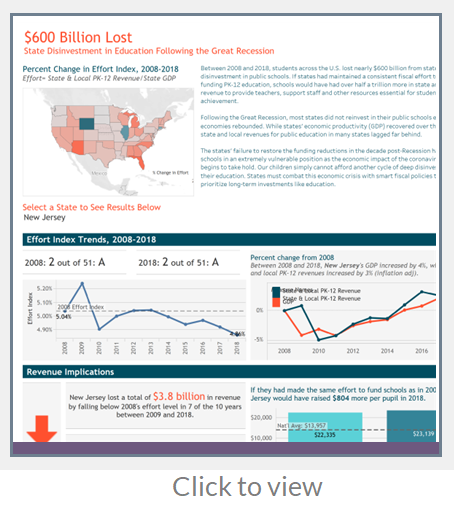$4 BILLION LOST: A DECADE OF DISINVESTMENT IN NEW JERSEY’S PUBLIC SCHOOLS
In the decade following the Great Recession, New Jersey public schools lost nearly $4 billion by not maintaining school funding on pace with the state’s economic growth. In addition, in 2018, the state’s high poverty districts received less funding than low poverty districts, dropping New Jersey to a “C” grade on the all-important measure of funding distribution.
These findings are highlighted in two Education Law Center research reports issued last month:
- $600 Billion Lost: State Disinvestment in Education Following the Great Recession. This report calculates the cost incurred by states not maintaining a consistent effort to fund public education measured by the level of state and local PK-12 funding as a percentage of the state’s overall economic output, or GDP.
- Making the Grade 2020. ELC’s annual school funding report card ranks and grades the states on three measures: funding level, funding distribution and funding effort.
“If lawmakers had maintained a consistent effort to fund our schools since 2008, New Jersey would be much closer to eliminating the current $2.5 billion ‘adequacy gap’ in nearly 200 districts below the mandated levels in the state’s school funding formula, the School Funding Reform Act (SFRA),” said Danielle Farrie, ELC Research Director and co-author of the reports.
On the Making the Grade report card, New Jersey’s grades on school funding for 2018 are:
- “A” on funding level, ranking 5thout of 51 with cost-adjusted, per pupil funding levels that are more than $5,000 above the national average;
- “C” or “flat” funding distribution with high-poverty districts, on average, receiving slightly less funding per pupil than low-poverty districts;
- “A” on funding effort for the state’s higher-than-average effort made to fund schools.
Though New Jersey performs relatively well compared to most other states, the reports highlight the lost opportunities to prioritize school funding during the state’s recovery from the Great Recession. If lawmakers had simply maintained the same level of effort in funding education as before the 2008 Recession, the average per pupil funding level would have been $800 higher in 2018.
New Jersey’s “C” grade on funding distribution in 2018 marks a sharp retreat from a school finance system that was once among the most progressive in the nation. Instead of providing significantly more funding to high poverty districts, funding levels have eroded to the point where they are even or “flat.” This condition runs counter to the core principle of the SFRA formula, which was designed to direct additional funding to districts with high enrollments of low-income, at-risk students.
The erosion of school funding equity in New Jersey comes at a time when the impacts of COVID-19 on students and schools requires more, not fewer, resources for vulnerable student populations, including students of color, students with disabilities, and students in households experiencing unemployment, homelessness, and trauma from the loss of family members.
“For New Jersey to reclaim its place as a national model of equitable and adequate school funding, lawmakers must commit to a progressive revenue plan that will provide the funding needed to deliver on the promise of the SFRA,” Dr. Farrie said. “Governor Murphy’s proposal to increase PK-12 funding by over $600 million in the FY22 budget is a promising first step toward closing persistent funding gaps, especially in the state’s low-income districts.”
Visit Making the Grade to download reports and view tools for advocates, including Making the Grade and $600 Billion Lost state profiles for New Jersey and other states.
Press Contact:
Sharon Krengel
Policy and Outreach Director
skrengel@edlawcenter.org
973-624-1815, x 24
Press Contact:
Sharon Krengel
Director of Policy, Strategic Partnerships and Communications
skrengel@edlawcenter.org
973-624-1815, x240

